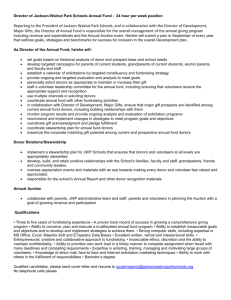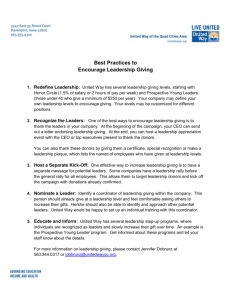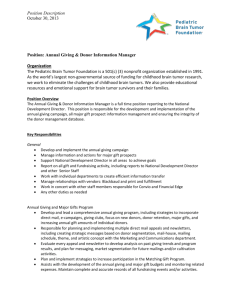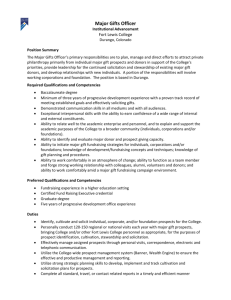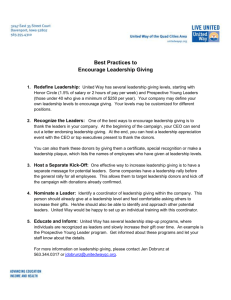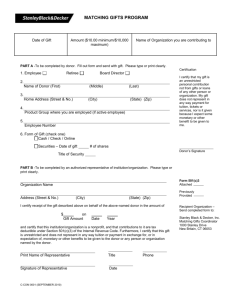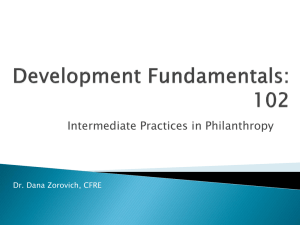glossary of fundraising terms - California 4
advertisement
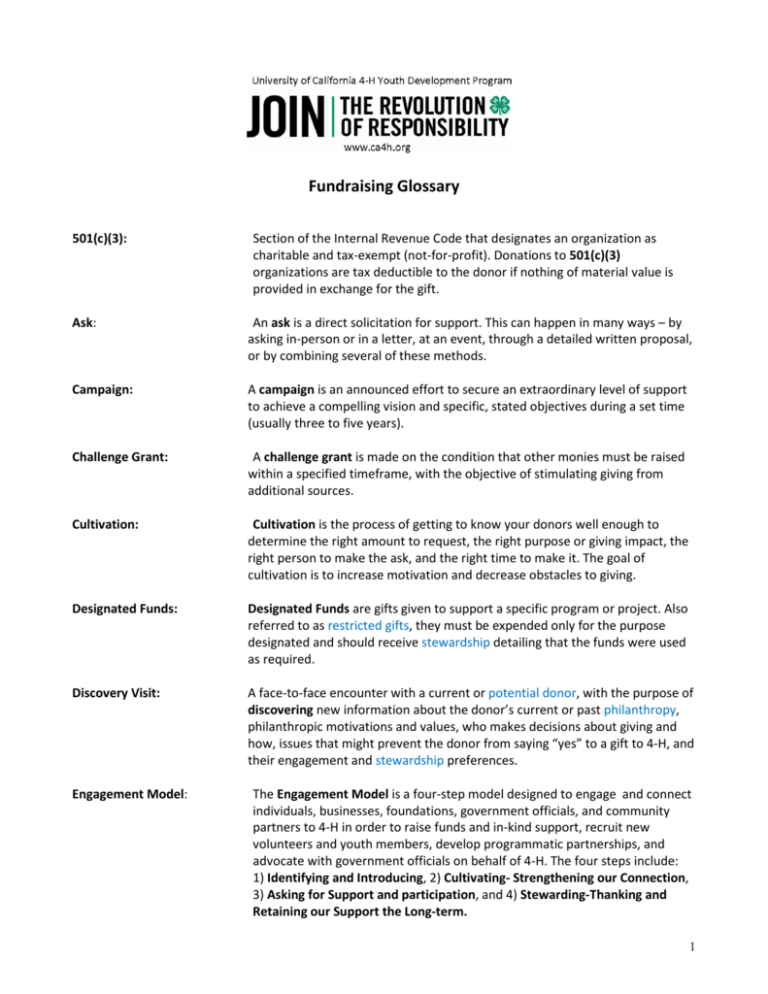
Fundraising Glossary 501(c)(3): Section of the Internal Revenue Code that designates an organization as charitable and tax-exempt (not-for-profit). Donations to 501(c)(3) organizations are tax deductible to the donor if nothing of material value is provided in exchange for the gift. Ask: An ask is a direct solicitation for support. This can happen in many ways – by asking in-person or in a letter, at an event, through a detailed written proposal, or by combining several of these methods. Campaign: A campaign is an announced effort to secure an extraordinary level of support to achieve a compelling vision and specific, stated objectives during a set time (usually three to five years). Challenge Grant: A challenge grant is made on the condition that other monies must be raised within a specified timeframe, with the objective of stimulating giving from additional sources. Cultivation: Cultivation is the process of getting to know your donors well enough to determine the right amount to request, the right purpose or giving impact, the right person to make the ask, and the right time to make it. The goal of cultivation is to increase motivation and decrease obstacles to giving. Designated Funds: Designated Funds are gifts given to support a specific program or project. Also referred to as restricted gifts, they must be expended only for the purpose designated and should receive stewardship detailing that the funds were used as required. Discovery Visit: A face-to-face encounter with a current or potential donor, with the purpose of discovering new information about the donor’s current or past philanthropy, philanthropic motivations and values, who makes decisions about giving and how, issues that might prevent the donor from saying “yes” to a gift to 4-H, and their engagement and stewardship preferences. Engagement Model: The Engagement Model is a four-step model designed to engage and connect individuals, businesses, foundations, government officials, and community partners to 4-H in order to raise funds and in-kind support, recruit new volunteers and youth members, develop programmatic partnerships, and advocate with government officials on behalf of 4-H. The four steps include: 1) Identifying and Introducing, 2) Cultivating- Strengthening our Connection, 3) Asking for Support and participation, and 4) Stewarding-Thanking and Retaining our Support the Long-term. 1 Foundation: A foundation is a not-for-profit entity established with the purpose of making philanthropic grants. There are four main types of foundations: 1) Family foundations, established within a single family for charitable giving, 2) corporate foundations, the philanthropic wing of a for-profit business, 3) private foundations, often established initially as a family foundation, but often having a formal structure and staff and 4) community foundations, often composed of a group of donors within a community who pool their funds for charitable purposes. Fund Development: Fund Development is an integrated approach to fundraising that focuses on advancing the 4-H mission and building relationships with donors and prospective donors using a full range of fundraising techniques and methods (direct mail, web-based giving, special events, annual giving, major gifts, planned giving, corporate giving, foundation giving). Fundraising Plan: A Fundraising Plan identifies the different fundraising activities will you conduct, due dates, and who will do what to achieve your funding goals. It includes plans for fundraising from all sources: individuals, corporations and foundations; and through all fundraising activities: mail, phone, email/online, special events, grants, face-to-face solicitation. Gift In-Kind: A Gift In-Kind is any gift other than cash or securities used to support your project. For example, printing invitations, donating food or drink for an event, or providing materials or equipment for your projects are all gifts in-kind. Impact Statements: An impact statement tells people why what you do should matter to them. Impact statements answer the following questions: what does my gift support? What difference does this make in the lives of people we serve? What are the expected impacts and outcomes of this investment? Major Gift: A gift of $1,000 or more per year is considered a major gift. Solicitation or acceptance of a major gift requires approval of the county director. The California 4-H Foundation will partner with local groups to solicit gifts of this size. Mission: Your mission is the reason your organization exists and the measurable outcome you are trying to create. The mission of the University of California 4H Youth Development Program is to help each child reach their full potential while advancing the field of youth development. The mission of the Revolution of Responsibility is to provide opportunities for youth to learn leadership by leading while making important contributions to their communities in the process. Operating Support: A contribution that is given to cover an organization's day-to-day, ongoing expenses, such as salaries, utilities, and office supplies is considered to be for operating support. Philanthropy: The origin of the word philanthropy is Greek and means love for humankind. Today, philanthropy includes the concept of voluntary giving by an individual 2 or group to promote the common good. Philanthropy also commonly refers to grants and gifts of money given to nonprofit organizations that in turn work for the improvement of the quality of life for all citizens. Pledge: A pledge is a promise to make future contributions to an organization. For example, some donors make multi-year pledges promising to give a specific amount of money each year. Prospect or Potential Donor: Individuals, corporations or foundations that you have determined have the capacity and inclination to give a gift to 4-H. Restricted Gift: A restricted gift, also referred to as a designated gift, is restricted in its use, ear-marked for a specific purpose, program or project. Solicitation visit: A solicitation visit is as face-to-face encounter during which a specific amount is requested to help support the work you do. Sponsorship: Sponsorship often refers to the support or underwriting given to a project or event by a company, foundation, or individual. Stewardship: Stewardship includes spending the donor's money as agreed, thanking the donor within 24 to 72 hours, managing funds prudently, recognizing gifts appropriately, and demonstrating over time, and in creative and pleasing ways, the impact of the donor's gift. Treasure Map: A treasure map is a tool to identify and develop strategies to engage groups, businesses, and people with 4-H, the resources they have to share (“treasure” that they have that we need) and their self-interest (their motives for being engaged, i.e. giving their money, volunteering, supporting us in other ways) – or, the treasure they can potentially expect from us in return. This tool is useful for identifying potential donors, volunteers, partners, connections and those with specific expertise. Unrestricted Gifts: When a donor does not specifically earmark a purpose or particular uses for a gift, it is called and unrestricted gift. Considered most beneficial to 4-H, an unrestricted gift permits the program to use the gift where it can do the most good. Most annual gifts are unrestricted. This Resource based on the glossary created by the Osborne Group, Inc. for the National 4H Council. 3
